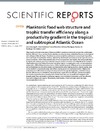Please use this identifier to cite or link to this item:
http://hdl.handle.net/10553/58381
| Title: | Planktonic food web structure and trophic transfer efficiency along a productivity gradient in the tropical and subtropical Atlantic Ocean | Authors: | Armengol, Laia Calbet, Albert Franchy, Gara Rodriguez-Santos, Adriana Hernandez-Leon, Santiago |
UNESCO Clasification: | 251001 Oceanografía biológica | Keywords: | Phytoplankton Growth Community Structure Microbial Control Size-Structure Rates, et al |
Issue Date: | 2019 | Project: | "Migradores y Flujo Activo en El Océano Atlántico" | Journal: | Scientific Reports | Abstract: | Oligotrophic and productive areas of the ocean differ in plankton community composition and biomass transfer efficiency. Here, we describe the plankton community along a latitudinal transect in the tropical and subtropical Atlantic Ocean. Prochlorococcus dominated the autotrophic community at the surface and mixed layer of oligotrophic stations, replaced by phototrophic picoeukaryotes and Synechococcus in productive waters. Depth-integrated biomass of microzooplankton was higher than mesozooplankton at oligotrophic stations, showing similar biomasses in productive waters. Dinoflagellates dominated in oligotrophic waters but ciliates dominated upwelling regions. In oligotrophic areas, microzooplankton consumed ca. 80% of the production, but ca. 66% in upwelling zones. Differences in microzooplankton and phytoplankton communities explain microzooplankton diel feeding rhythms: higher grazing rates during daylight in oligotrophic areas and diffuse grazing patterns in productive waters. Oligotrophic areas were more efficient at recycling and using nutrients through phytoplankton, while the energy transfer efficiency from nutrients to mesozooplankton appeared more efficient in productive waters. Our results support the classic paradigm of a shorter food web, and more efficient energy transfer towards upper food web levels in productive regions, but a microbially dominated, and very efficient, food web in oligotrophic regions. Remarkably, both models of food web exist under very high microzooplankton herbivory. | URI: | http://hdl.handle.net/10553/58381 | ISSN: | 2045-2322 | DOI: | 10.1038/s41598-019-38507-9 | Source: | Scientific Reports [ISSN 2045-2322], v. 9, 2044 |
| Appears in Collections: | Artículos |
SCOPUSTM
Citations
89
checked on Mar 30, 2025
WEB OF SCIENCETM
Citations
86
checked on Mar 30, 2025
Page view(s)
135
checked on Sep 7, 2024
Download(s)
142
checked on Sep 7, 2024
Google ScholarTM
Check
Altmetric
Share
Export metadata
Items in accedaCRIS are protected by copyright, with all rights reserved, unless otherwise indicated.
